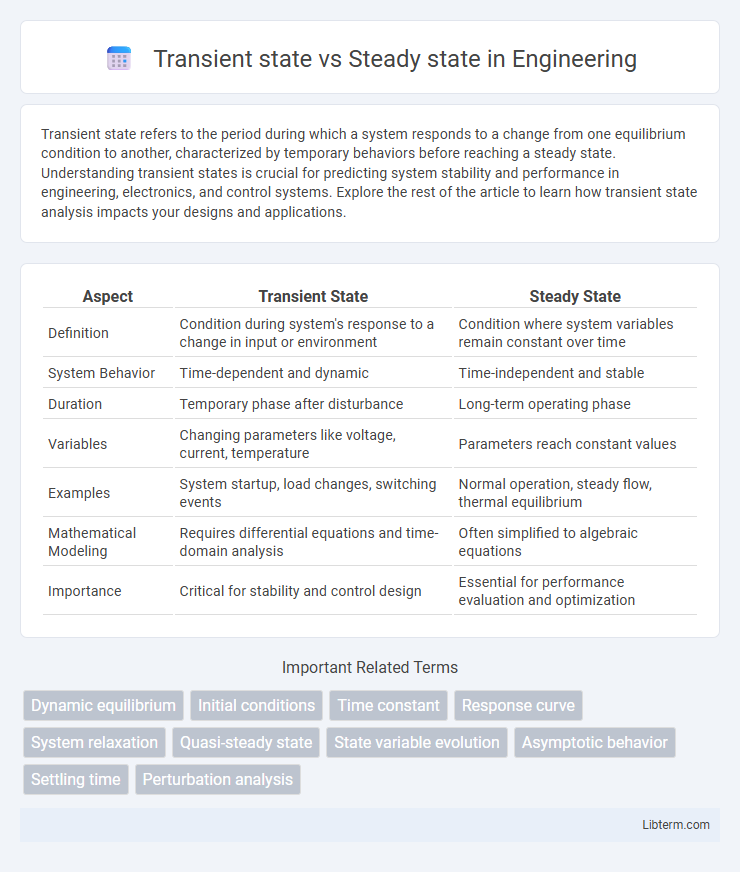Transient state refers to the period during which a system responds to a change from one equilibrium condition to another, characterized by temporary behaviors before reaching a steady state. Understanding transient states is crucial for predicting system stability and performance in engineering, electronics, and control systems. Explore the rest of the article to learn how transient state analysis impacts your designs and applications.
Table of Comparison
| Aspect | Transient State | Steady State |
|---|---|---|
| Definition | Condition during system's response to a change in input or environment | Condition where system variables remain constant over time |
| System Behavior | Time-dependent and dynamic | Time-independent and stable |
| Duration | Temporary phase after disturbance | Long-term operating phase |
| Variables | Changing parameters like voltage, current, temperature | Parameters reach constant values |
| Examples | System startup, load changes, switching events | Normal operation, steady flow, thermal equilibrium |
| Mathematical Modeling | Requires differential equations and time-domain analysis | Often simplified to algebraic equations |
| Importance | Critical for stability and control design | Essential for performance evaluation and optimization |
Introduction to Transient and Steady States
Transient state refers to the period in a system where variables such as temperature, pressure, or voltage are changing and have not yet reached equilibrium. Steady state occurs when these variables stabilize and remain constant over time despite ongoing processes or inputs. Understanding the transition from transient to steady state is crucial for analyzing dynamic systems in fields like thermodynamics, electrical engineering, and chemical reactions.
Defining the Transient State
The transient state in a system refers to the period during which the system undergoes change from an initial condition to a steady state, characterized by time-dependent variations in variables such as temperature, pressure, or voltage. This phase is crucial in control systems, chemical reactions, and thermal processes where dynamic behavior influences performance and stability. Understanding transient state behavior enables accurate prediction and control of system responses before equilibrium is reached.
Understanding the Steady State
Steady state refers to a condition where all variables in a system remain constant over time despite ongoing processes, indicating equilibrium between inputs and outputs. In control systems and chemical processes, steady state occurs after transient effects dissipate and the system stabilizes, allowing consistent performance metrics. Understanding steady state is crucial for designing efficient systems, optimizing reactions, and ensuring reliable operation under constant conditions.
Key Differences between Transient and Steady States
Transient state refers to the period during which a system experiences change or adjustment before reaching equilibrium, characterized by variable system parameters like temperature, pressure, or voltage. Steady state occurs when these parameters stabilize and remain constant over time, indicating the system has reached equilibrium. Key differences include time-dependence, with transient state being time-variant, whereas steady state is time-invariant, and dynamic changes only exist in transient conditions, while steady state exhibits consistent behavior.
Importance in Engineering and Science
Understanding transient state behavior is crucial for designing systems that must respond to changes, ensuring safety and stability during start-up, shutdown, or disturbances. Steady state analysis allows engineers and scientists to predict long-term performance, optimize efficiency, and achieve consistent operational conditions. Both transient and steady state evaluations are fundamental in fields such as chemical reactor design, electrical circuit analysis, and thermal system management, directly impacting reliability and control strategies.
Examples of Transient State in Real-World Systems
Transient state occurs in electrical circuits when a switch is turned on, causing sudden changes in current and voltage before reaching stability. In thermal systems, transient state is observed during the heating or cooling phase, such as a cup of coffee cooling to room temperature. Mechanical systems like a car accelerating from rest show transient behavior as forces and velocities adjust before steady cruising speed is reached.
Applications of Steady State in Various Fields
Steady state conditions are crucial in engineering, where they ensure predictable system behavior for process control in chemical reactors, electrical circuits, and thermal systems. In environmental science, steady state models help analyze long-term pollutant distribution and ecosystem equilibrium. Medical applications leverage steady state pharmacokinetics to optimize drug dosing for consistent therapeutic effects.
Mathematical Representation and Analysis
Transient state analysis involves solving differential equations that describe system behavior over time with initial conditions, capturing changes before reaching equilibrium. Steady state analysis simplifies these models by setting time derivatives to zero, transforming differential equations into algebraic equations representing constant system outputs. Mathematical representation of transient states typically uses Laplace transforms and state-space models, while steady state solutions rely on solving linear or nonlinear algebraic equations for system stability and performance assessment.
Challenges in Achieving Steady State
Achieving steady state in dynamic systems faces challenges such as unpredictable external disturbances, system nonlinearities, and time delays in feedback control mechanisms. Variations in input conditions or parameter changes can prolong transient states, preventing the system from settling into steady state. Robust control design and accurate modeling are essential to mitigate these issues and ensure reliable steady-state performance.
Conclusion: Choosing Between Transient and Steady State
Selecting between transient and steady state analysis depends on the specific requirements of the system's performance evaluation. Transient state analysis is crucial for understanding time-dependent behaviors immediately after system changes, while steady state analysis provides insights into long-term system stability and operating conditions. Engineers prioritize transient analysis for dynamic response optimization and steady state analysis for efficiency and durability assessments.
Transient state Infographic

 libterm.com
libterm.com